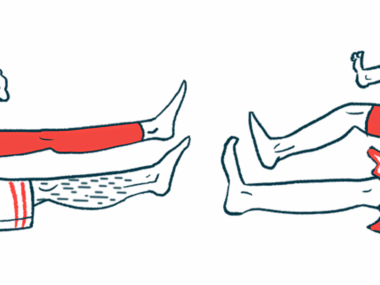Assistive Device Makes It Easier to Self-administer Nabiximols: Study
Written by |

An assistive device made it significantly easier and more comfortable for multiple sclerosis (MS) patients with arm and hand mobility problems to self-administer nabiximols — an oral spray containing compounds found in the cannabis plant — a study found.
Trained nurses involved in the study agreed with its findings, and noted that the device — the Sativex assistance device or applicator — might help patients to independently give themselves their own medication. Such easier administration potentially could result in fewer missed doses, according to researchers.
“The clearly positive feedback from patients with MS-related upper limb/hand impairment and healthcare professionals about the usability of the nabiximols application device supports its use in suitable patients in everyday clinical practice,” the team wrote.
The study, “Usability of an application device for nabiximols oromucosal spray in patients with upper limb impaired multiple sclerosis,” was published in the journal Neurodegenerative Disease Management.
Spasticity, marked by involuntary muscle contractions leading to jerky, uncontrolled movements, is a common and debilitating MS symptom. It often results in reduced hand and arm strength and mobility.
Nabiximols, developed by GW Pharmaceuticals, now part of Jazz Pharmaceuticals, is an oral spray containing compounds found in the cannabis plant. It is approved in Canada and most European countries, under the brand name Sativex, as an add-on therapy for managing moderate to severe spasticity in MS patients who failed to respond to other anti-spastic medications.
The therapy has not received approval in the U.S.
Administered in up to 12 sprays a day to the inside of the cheek or under the tongue, the therapy’s safety and efficacy were established in several clinical trials. Its use subsequently has been supported by real-world studies.
But for patients who have spasticity that affects the function of their arms and hands, pressing down on the spray nozzle to deliver the medication into their mouth can be a significant challenge.
With this in mind, Almirall — which markets nabiximols in several European countries — developed the Sativex assistance device or applicator. Fitted over the top of the nabiximols bottle, the device was designed to reduce the strength needed to administer the spray.
In pre-production testing among 15 MS patients who used nabiximols, 73% reported better application of the medicine with the device, and more than half (54%) said that less strength was required with its use.
The applicator earned European approval in 2019 and was made freely available to MS patients with impaired upper limb function who were using nabiximols.
Now, researchers in Italy aimed to validate the earlier pre-production findings in a larger group of MS patients. Their study involved 60 people with MS seen at their clinic in Pozzilli between September and December 2020.
Patients were invited to participate if they experienced upper limb spasticity and impaired finger dexterity in both hands, and had been using nabiximols for at least two years.
All participants — 31 women and 29 men — had moderate to severe MS disability and spasticity. Their mean age was 49.9 (range, 36–68 years), and they had been living with the disease for a mean of 22 years, with spasticity occurring for a mean of 8.5 years. The patients had been using nabiximols for a mean of 3.3 years, at a mean dose of 6.3 sprays per day (range, 4–8 sprays).
Most (80%) said they experienced difficulties using the oral spray, with 11% needing the help of a caregiver and 8.3% reporting missed doses due to difficulties using the spray bottle.
After first being given a set of written instructions that included pictures, the patients tested the Sativex device. They then were given a verbal explanation and demonstration of the device, and were invited to test it again.
After the testing, a trained nurse administered an 18-item questionnaire regarding the patients’ opinions on the device. Each question was scored on a scale of 1-10, with 10 generally indicating more satisfaction with the device.
Results showed that all patients were able to assemble and disassemble the application device. The comprehensibility of the instructions was rated between eight and 10, with a mean of 9.7 or higher. The applicator’s usability was given scores between seven and 10, with a mean of 9.5 or higher. These scores indicated an overall good to optimal rating.
Similarly, ratings relating to the device’s ergonomic features — its handling, carrying, and holding — and ease of operation were all deemed optimal. The mean scores on these features ranged from 8.9 to 9.4, depending on the question. The general ability of the Sativex device to simplify self-administration also was deemed optimal.
Participants also said they were highly likely to use the device (mean score of 9.8) and to recommend it to their friends (mean score of 9.9).
The nurses who administered the questionnaire also considered the device easy to use, with optimal potential for helping patients with self-administration. The mean score for both factors was 10.
While the device’s safety “was not formally assessed during testing, no issues were reported,” the researchers wrote.
“Overall, feedback about the device in the real-world setting was more favorable than that received during pre-production testing carried out in Spain, which was highly encouraging given that participating patients represented the group most likely to need the device,” the report said.
These more favorable responses may be due to the resolution of malfunctioning issues encountered when the earlier prototypes of the device were tested, the team suggested.
They noted, however, that since participants in this study were required to give their questionnaire responses directly to a nurse, instead of anonymously, they may have been more hesitant to share any concerns about the applicator.
Nonetheless, “it might be speculated that the application device can enhance adherence to nabiximols treatment in the mid/long term, facilitating the intake of medication as prescribed and reducing the risk of missed doses,” the team concluded. Such outcomes, however, would “require confirmation in a well-controlled, long-term follow-up study,” they noted.






